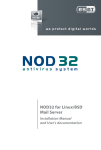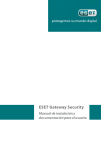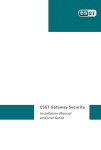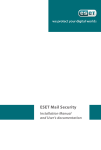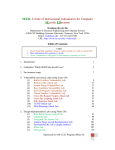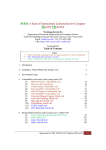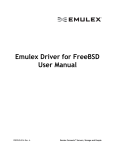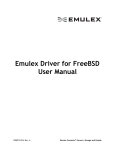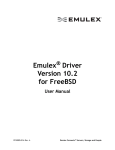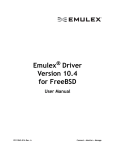Download ESET NOD32 ANTIVIRUS - FOR LINUX-BSD MAIL SERVER Installation manual
Transcript
we protect digital worlds NOD32 for Linux/BSD File Server Installation Manual and User’s documentation Table of contents NOD32 for Linux/BSD File Server, First Edition Published on 6th December 2006 Copyright © 2006 Eset, s.r.o. NOD32 for Linux/BSD File Server was developed by Eset, s.r.o. For more information visit www.nod32.com.sg. All rights reserved. No part of this documentation may be reproduced, stored in a retrieval system or transmitted in any form or by any means, electronic, mechanical, photocopying, recording, scanning, or otherwise without a permission in writing from the author. Eset, s.r.o. reserves the right to change any of the described application software without prior notice. Exclusive Distributor Version 2 Singapore Pte Limited Sales Hotline: (65) - 6296 4268 E-mail: [email protected] Support Hotline: (65) - 6297 2069 E-mail: [email protected] Fax: (65) - 6296 4252 Website: http://www.nod32.com.sg 1. Introduction ........................................................... 3 2. Installation.............................................................. 5 3. Product’s Roadmap .................................................. 7 4. Integration with Linux/BSD File System ....................11 4.1. On-demand scanner........................................................... 12 4.2. On-access scanner .............................................................. 12 4.2.1. On-access scanner powered by Dazuko ........................... 13 4.2.1.1. Operation principle....................................................... 13 4.2.1.2. Installation and configuration ...................................... 14 4.2.1.3. Tips ............................................................................... 15 4.2.2. On-access scanner using preload LIBC library .................. 16 4.2.2.1. Operation principle....................................................... 16 4.2.2.2. Installation and configuration ...................................... 16 4.2.2.3. Tips ............................................................................... 17 5. Important NOD32LFS/NOD32BFSMechanisms ............19 5.1. User Specific Configuration................................................. 20 5.2. Handle Object Policy .......................................................... 20 5.3. Samples Submission System .............................................. 21 6. NOD32 system update and maintenance ...................23 6.1. Basic concept of NOD32 system update .............................. 24 6.1.1. NOD32 mirror creation..................................................... 24 6.1.2. Generation of NOD32 scanner loading modules .............. 24 6.2. Automatic update of the virus definitions database ........... 25 7. Let us know ............................................................27 NOD32 for Linux/BSD File Server Chapter 1: 1 Introduction Introduction Dear user, you have acquired NOD32 for Linux/BSD File Server - NOD32LFS/NOD32BFS - probably the best antivirus system running under the Linux/BSD OS. As you will soon find out, the system using, the state-of-the-artNOD32 scanning engine, has unsurpassed scanning speed and detection rate, combined with a very small footprint that makes it the ideal choice for any Linux/BSD OS server. In the rest of this chapter we review a key features of the system. • NOD32 scanning engine algorithms provide both the highest detection rate and the fastest scanning times. • The system is developed to run on the single-processor units as well as on themulti-processor units. • It includes unique advanced heuristics for Win32 worms and back-doors. • InbuiltNOD32 archivers unpack archived objectswithout the need for any external programs. • In order to increase speed and efficiency of the system, its architecture is based on the running daemon (resident program) where all the scanning requests are sent to. • The system supports selective scanner configuration specific for user or client/server identification. • Six various levels of logging can be configured to get information about system activity and infiltrations. • One of the major advantages is the fact that the system installation does not require external libraries or programs except for LIBC. • The system can be configured to notify any person in case of detected infiltration. To run efficiently, the system requires just 16MB of hard-disk space and 32MB of RAM. The system runs smoothly under the 2.2.x, 2.4.x and 2.6.x Linux OS kernel versions and also under 5.x, 6.x FreeBSD OS kernel versions. From lower-powered, small office servers to enterprise-class ISP servers with thousands of users, the system delivers the performance and scalability you expect from a UNIX based solution and the unequaled security of NOD32. NOD32 for Linux/BSD File Server Chapter 2: 2 Installation Installation This product is distributed as a binary file. Its format for Linux OS is: nod32ls.i386.ext.bin where ’ext’ is a Linux OS distribution dependent suffix, i.e. ’deb’ for Debian Linux OS distribution, ’rpm’ for RedHat and SuSE Linux OS distributions, ’tgz’ for other Linux OS distributions. Note that we support also RedHat Ready and Novell (SuSE) Ready variation of the product The RedHat and Novell (SuSE) Ready variation of the binary file format is: nod32ls-rsr.i386.rpm.bin Slightly different format is used to name the binary file for BSD OS, nod32bs.i386.ext.tgz.bin where ’ext’ stands for BSD OS distribution dependent suffix, i.e. ’fbs4’ for FreeBSD 4.xx, ’fbs5’ for FreeBSD 5.xx and ’fbs6’ for FreeBSD 6.xx OS distributions. In order to install or update the product on Linux OS, use the statement: sh ./nod32ls.i386.ext.bin resp. the RedHat Ready or Novell (SuSE) Ready variation of the product is installed using the following statement: sh ./nod32ls-rsr.i386.rpm.bin In case of BSD OS, the install statement is as follows. sh ./nod32bs.i386.ext.tgz.bin As a result the User License Acceptance Agreement related with the product is shown. Once you have confirmed the Acceptance Agreement, the whole installation package is extracted into the current working directory and relevant information regarding installation or update of the package extracted as well as information necessary for uninstall the already installed package is printed into terminal. Once the package is installed and the main NOD32 daemon service is running, in Linux OS you can check its operation by using command: ps -C nod32d In case of BSD OS you can use a similar command: ps -ax nod32d | grep nod32d You will see the following (or similar) message on return: PID 2226 2229 TTY ? ? TIME 00:00:00 00:00:00 CMD nod32d nod32d where at least two main NOD32 daemon ’nod32d’ processes running in the background have to be present. One of the processes is so-called process and threads manager of the system. The other serves as NOD32 scanning process. )The difference from the original RedHat and SuSE Linux OS package is that the RedHat Ready and Novell (SuSE) Ready package meets criteria defined by FHS (File-system Hierarchy Standard defined as a part of Linux Standard Base) document required by the RedHat Ready and Novell (SuSE) Ready certificate. This means in particular that the package is installed as an add-on application, i.e. the primary installation directory is ’/opt/eset/nod32’ instead of the base Linux OS directory structure. However, there are more differences between the original and ’Ready’ variation of the product that are beyond the scope of this document. NOD32 for Linux/BSD File Server Chapter 3: 3 Product’s Roadmap Product’s Roadmap Once the product package has been successfully installed, it is time to become familiar with its content. The structure of the NOD32LFS/NOD32BFS is shown in the figure 3-1. The system is composed of the following components. Figure 3-1. Structure of NOD32LFS/NOD32BFS. AGENTS nod32dac CORE nod32d libnod32.so nod32.00X libnod32pac.so nod32 CONFIGURATION nod32.cfg license scripts UPDATE nod32_update nod32update templates extern CORE Core of the NOD32LFS/NOD32BFS consists of main NOD32 system control and scanning daemon module nod32d. The daemon uses NOD32 API library libnod32.so and NOD32 loading modules nod32.00X to provide essential system tasks: anti-virus scanning, maintenance of the agent daemon processes, maintenance of the samples submission system, logging, notification, etc.. To get detailed information on the main NOD32 system control and scanning daemon, refer to nod32d(8) manual page. AGENTS The purpose of NOD32 agent modules is to integrate the NOD32LFS/NOD32BFS with the Linux/BSD file system environment. Please note a special chapter in this document devoted to the topic. UPDATE The update utilities create a particular fraction of the system. They are built with only one purpose, i.e. update of NOD32 loading modules containing for instance virus signatures database, archives support, advanced heuristics support etc. Please note a special chapter in this document devoted to the topic. CONFIGURATION Proper configuration is the most important condition for the system operation. Therefore we describe all the related components in the rest of this chapter. We also strongly recommend to read nod32.cfg(5) manual page, an essential information source regarding NOD32LMS/NOD32BMS configuration. After the product package is successfully installed, all the components related to its configuration and authorization are stored in directory /etc/nod32 NOD32 for Linux/BSD File Server Note that in case of RedHat Ready and Novell (SuSE) Ready variation of the NOD32 for Linux Mail Server the configuration and authorization directory is /etc/opt/eset/nod32 The directory consists of the following files. nod32.cfg This is the most important configuration file as it maintains the major part of the product functionality. For this reason the file is further referred to as ‘main configuration file‘ or ‘main NOD32 configuration file‘. After exploring the file you can see that it is built from various parameters distributed within sections. Note the section names always enclosed in square brackets. In the main configuration file there is always one global and several so-called agent sections. Parameters in global section are used to define configuration options of main NOD32 daemon ‘nod32d‘ as well as default values of NOD32 scanning engine configuration options. Parameters in agent sections are used to define configuration options of so-called agents, i.e. modules used to intercept various data flow types in the computer and/ or its neighborhood and prepare this data for anti-virus scanning. Note that besides the number of parameters used for the system configuration, there is also a number of rules determining organization of configuration file. To become familiar with this knowledge. please refer to nod32.cfg(5), nod32d(8) manual page and also to manual pages related to relevant agents. license This directory is used to store the product license key you have acquired fromyour vendor. Note that the main NOD32 daemon will always check only this directory to evaluate license key validity unless it is redefined by the main configuration file parameter ’nod32_lic_dir’. scripts/nod32d_license_warning_script This script, if enabled by main configuration file parameter ’license_warn_enabled’, is executed since 30 days (once per day) before product license expiration. It is used to send e-mail notification about the expiration status to system administrator. scripts/nod32d_script This script, if enabled by main configuration file parameter ’exec_script’, is executed in case the infiltration has been detected by the anti-virus system. It is used to send e-mail notification about the event to system administrator. chapter 3 / Product’s Roadmap NOD32 for Linux/BSD File Server Chapter 4: 4 Integration with Linux/BSD File System Integration with Linux/BSD File System This chapter describes process of configuration of NOD32LFS/NOD32BFS system in order to provide an efficient protection from virus and worm infections of the file systems by using ondemand and on-access scanning techniques. The NOD32 for Linux/BSD File Server is composed from the so-called on-demand scanner ‘nod32‘ and so-called onaccess scanner ’nod32dac’. The Linux version of the products implements also additional on-access scanner technique using preload library module ’libnod32pac.so. All concerned components are described in the following sections. 4.1. On-demand scanner On-demand scanner is scanner that can be invoked by privileged user (usually system administrator) using command line interface or by operating systemusing periodic command scheduler. This is also an explanation of the term ’on-demand’ that the file system objects are scanned on user and/or system demand. Concerning NOD32 on-demand scanner there are not special requirements for its operation. After proper installation of theNOD32LFS/NOD32BFS package and after valid license has been provided within the license keys directory feel free to run on-demand scanner by using command line interface or scheduler tool. In order to run on-demand scanner from command line the following syntax is expected /usr/sbin/nod32 [option(s)] INCL_SCAN_DIR -- -EXCL_SCAN_MASK Note that in Linux RedHat Ready and Novell (SuSE) Ready variation of the product an appropriate command will look as follows. /opt/eset/nod32/sbin/nod32 [option(s)] INCL_SCAN_DIR -- -EXCL_SCAN_MASK where INCL_SCAN_DIR (resp. EXCL_SCAN_MASK) is list of directories and/or files to be scanned (resp. excluded from scanning). Multiple command line options are implemented within NOD32 on-demand scanner. To get full list of them, please, read appropriate manual page for NOD32 on-demand scanner nod32(8). Tip: As indicated already it is good idea to use on-demand scanner on the regular basis to protect operating system. Next example shows how to set periodic command scheduler ’cron’ for running on-demand scanner each day at 3AM. In order to do so one has to enter the following line into the ’cron’ table (use statement ’crontab -e’ for this purpose): 0 3 * * * /usr/sbin/nod32 [option(s)] INCL_SCAN_DIR -- -EXCL_SCAN_DIR Note that in Linux RedHat Ready and Novell (SuSE) Ready variation of the product an appropriate command line will look as follows. 0 3 * * * /opt/eset/nod32/sbin/nod32 [option(s)] INCL_SCAN_DIR \ -- -EXCL_SCAN_DIR Please note that there is no configuration file interface supported for this module. 4.2. On-access scanner On-access scanner is scanner invoked by predefined triggered access of user(s) and/or operating systemto the file systemobjects. This also explains the term ‘on-access‘; the scanner is started on attempt to access selected file system object. TheNOD32LFS/NOD32BFS technique based on kernel calls interception is powered by Dazuko (read da-tzu-ko) kernelmodule. Dazuko project is a Free software, by means that it is distributed as a free source code, in order to allow users compilation of the kernelmodule for their own custom kernels. Note that the Dazuko kernel module is not a part 12 NOD32 for Linux/BSD File Server of the NOD32LFS/NOD32BFS product and thus it must be compiled and installed into the kernel prior the NOD32 onaccess scanner (nod32dac daemon) initialization. On the other hand the Dazuko technique make on-access scanning independent of used file system type. It is also suitable for controlling file system objects via Network File System (NFS), Nettalk and Samba. The additional installation of the Dazuko module can be non-wished for Linux OS system administrators which carry on the critical systems where source code and/or configuration file appropriate to the currently running kernel is not available or the kernel is rather monolithic than modular. In this case the second discussed on-access scanning technique based on the preload LIBC library comes in handy. IMPORTANT: Before we provide user with the detailed information related with the on-access scanner configuration and operation, we would like to point out that any NOD32 on-access scanner is not assumed to provide protection of whole file system where installed. It has been developed and tested to protect primarily the file systems mounted externally. If this is not your case, you will have to count on exclusion of multiple directories from file access control to prevent system from hang-up. Typical directory to be excluded in this case is ‚/dev‘ directory or directories used by NOD32LFS/NOD32BFS. 4.2.1. On-access scanner powered by Dazuko This section contains information concerned with operation, installation and configuration of on-access scanner using Dazuko kernel module. 4.2.1.1. Operation principle On-access scanner ‘nod32dac’ (NOD32 Dazuko powered file Access Controller) is a resident program (daemon) providing permanent monitoring and control over the file system. Scanning of each file system object is performed upon customizable file access event of the user and/or operating system. The following file access types are supported by the current version: ON_OPEN events This file access type is controlled once the first bit of the integer parameter ’event_mask’ in the main NOD32 configuration file (section [dac]) is 1. In this case ON_OPEN bit of Dazuko access mask is set on. ON_CLOSE events This file access type is controlled once second bit of the integer parameter ’event_mask’ in the main NOD32 configuration file (section [dac]) is 1. In this case ON_CLOSE bit and ON_CLOSE_MODIFIED bit of Dazuko access mask is set on. Note that some of the kernel versions do not support interception of the ON_CLOSE events. In this case problems could be detected when running nod32dac module. ON_EXEC events This file access type is controlled once third bit of the integer parameter ‘event_mask’ in the main NOD32 configuration file (section [dac]) is 1. In this case ON_EXEC bit of Dazuko access mask is set on. By using this mechanism all opened, closed and executed regular files are scanned by daemon nod32d for viruses. Based on the result of this scanning the access to the files is denied or allowed. chapter 4 / Integration with Linux/BSD File System 13 4.2.1.2. Installation and configuration It has been already discussed that prior any ‘nod32dac’ initialization, so-called Dazuko kernel module has to be compiled and installed within the running kernel. Note that the following text contains only brief description of the Dazuko kernel module installation. Therefore it is highly recommended to read the Dazuko how-to-install documentation (see http://www.dazuko.org/howto-install.shtml) in order to compile and load the Dazuko module properly into the kernel. Download Dazuko tarball from (http://www.dazuko.org/downloads.shtml). Note that the NOD32 on-access scanner is compatible with the Dazuko kernel module whose version is equal or higher than 2.1.0. Therefore the proper behavior of NOD32 on-access scanner running with the older versions of Dazuko kernel module is not guaranteed. Before compilation of the Dazuko it is necessary to have a source code of currently running kernel stored in the kernel source code directory: /usr/src/linux* resp. in BSD OS the appropriate directory is: /usr/src/sys Note that it is important to have a version of the kernel source code exactlymatching the version of the kernel that is currently running on the operating system. Even if the kernel source code is present in the kernel source code directory, make sure that it is properly configured. Read the Dazuko FAQ related to this topic (http://www.dazuko.org/faq.shtml). Notes (for administrators running Linux OS kernel 2.6.x): When running multiple security modules, make sure the „Enable different security modules“ is enabled and the dazuko module is the first security module loaded into kernel. To get more information what has to be done during kernel configuration, please read the Dazuko FAQ related to this topic (http://www.dazuko.org/faq.shtml). Note also that the ’commoncap’ kernel module has to be loaded into kernel prior ’dazuko’ module. Generate the Makefile by running: ./configure within the Dazuko source code directory. Compile Dazuko code with: make which will create the ’dazuko.o’ file (note that for Linux 2.6 kernel and for BSD OS an appropriate file ’dazuko.ko’ is created). If any warnings or errors appeared as a consequence of the above steps, the Dazuko module was not compiled properly. In this case it is not recommended to go further over the next steps of this section but rather refer to the appropriate Dazuko documentation (http://www.dazuko.org/faq.shtml). Insert the dazuko module into kernel by typing /sbin/insmod dazuko.o resp. in BSD OS an appropriate command to insert the module is /sbin/kldload dazuko.ko and check that themodule is properly loaded. In the Linux OS the check can be done for instance by using: /sbin/lsmod or: cat /proc/modules In BSD OS the check can be done using command 14 NOD32 for Linux/BSD File Server /sbin/kldstat In all cases there should be Dazuko listed in the output of these commands. Unless the device node is created automatically, create it with: mknod -m 600 /dev/dazuko c $(grep dazuko /proc/devices | sed “s/ .*//“) 0 chown root:root /dev/dazuko resp. in BSD OS by using command mknod /dev/dazuko c 33 0 Read and edit [global] and [dac] sections of NOD32 main configuration file. Note also that for the proper functioning of on-access scanner it is necessary to enable nod32dac agent using ‚agent_enabled‘ parameter within a [dac] section of main NOD32 configuration file. Furthermore it is necessary to define file system objects (i.e. directories and files) that are required to be under control of dazuko kernel module. This can be achieved via ’ctl_incl’ and ’ctl_excl’ configuration options defined within [dac] section of the main NOD32 configuration file. IMPORTANT: Please, do not remove ‚/dev‘ directory from the control of on-access scanner (e.g. ctl_excl = “/dev“) unless you know exactly what you are doing, otherwise system can hang up. For reread of newly created NOD32 configuration, enter the following command. /etc/init.d/nod32d reload 4.2.1.3. Tips To provide Dazuko module loading prior each nod32dac daemon initialization, follow the next steps: Provide copy of Dazukomodule in some of the directories located within the directory reserved for the kernel modules /lib/modules or /modules Use the kernel utilities ’depmod’ and ’modprobe’ (resp. in BSD OS ‚kldconfig‘ and ‚kldload‘) to handle dependencies and proper loading of the newly added Dazuko module. Insert the following line into initialization script for main NOD32 scanning daemon ’/etc/init.d/nod32d’ before the daemon initialization statement. /sbin/modprobe dazuko Note that in BSD OS an appropriate line for inserting module is /sbin/kldconfig dazuko IMPORTANT: It is highly important to execute the individual steps above exactly in order as they are written. The reason is that in case of kernel module not located within the kernel modules directory, ’modprobe’ (resp. ’kldload’ in BSD OS) will not be able to handle loading of the module and the system can hang-up. 4.2.2. On-access scanner using preload LIBC library Note that this section is relevant only for users of NOD32LFS product. This section contains information concernedwith operation, installation and configuration of on-access scanner using preload library ‘libnod32pac.so’. chapter 4 / Integration with Linux/BSD File System 15 4.2.2.1. Operation principle On-access scanner ‘libnod32pac.so’ (NOD32 Preload library based file Access Controller) is a shared objects library that is used as a preload library of LIBC and can become functional during the system start-up. It is thus applicable for file system servers using LIBC calls, for instance ftp server, Samba server etc. Scanning of each file system object is performed upon customizable file access event of the user and/or operating system. The following file access types are supported by the current version: ON_OPEN events This file access type is controlled once first bit of the integer parameter ’event_mask’ in the main NOD32 configuration file (section [pac]) is 1. In this case all ’open’ or ’open64’ calls of the LIBC are intercepted. ON_CLOSE events This file access type is controlled once second bit of the integer parameter ’event_mask’ in the main NOD32 configuration file (section [pac]) is 1. In this case all ’close’, ’dup’ and ’dup2’ calls of the LIBC are intercepted. By using this mechanism all opened and closed descriptors tied to ‚kldconfig‘ and ‚kldload‘) to handle dependencies and proper loading result of this scanning the access to the files is denied or allowed. 4.2.2.2. Installation and configuration The ‘libnod32pac.so’ installation is done using standard installation mechanism of the preload libraries. One has just to define the environment variable ’LD_PRELOAD’ with absolute path pointing to the ‘libnod32pac.so’ library. Please refer also to the manual page ld.so(8) to get further information. IMPORTANT: It is important to note that the ’LD_PRELOAD’ environment variable has to be defined just for the network server daemon process (ftp, samba, etc.) we would like to have under control. Generally it is not recommended to preload LIBC calls in all operating system processes as for controlling the selected file system area it is not necessary and it can dramatically slow down the performance of the system or even cause the system hang-up. In this sense all mechanisms using ‚/etc/ld.so.preload‘ configuration file are not correct as well as mechanisms using ‚export LD_ PRELOAD‘ statement. Both would override all relevant LIBC calls in the whole system that will lead to the system hang-up during its initialization. Thus in order to intercept just relevant file access calls related with just objects within selected file system area, one has to override an executable statement of an appropriate network file system server with the following line LD_PRELOAD=/usr/lib/libnod32pac.so COMMAND COMMAND-ARGUMENTS where ’COMMAND COMMAND-ARGUMENTS’ is the original executable statement. Note also that for the proper run of on-access scanner it is necessary to define file system objects (i.e. directories and files) that are required to be under control of the preload library. This can be achieved via ’ctl_incl’ and ’ctl_excl’ configuration options defined within [pac] section of the configuration file. 4.2.2.3. Tips In order to provide on-access scanner functionality immediately after network file systemserver start-up, it is good to define environment variable ’LD_PRELOAD’ directly within an appropriate network file server initialization script. EXAMPLE: Let’s assume we would like to have on-access scanner catching all file system access events immediately after starting the samba server. Thus within the initialization script concerned with samba daemon (/etc/init.d/smb), we replace the statement daemon /usr/sbin/smbd $SMBDOPTIONS 16 NOD32 for Linux/BSD File Server responsible for initialization of smbd daemon by the following line LD_PRELOAD=/usr/lib/libnod32pac.so daemon /usr/sbin/smbd $SMBDOPTIONS In this manner selected file system objects controlled by Samba will be checked immediately after Samba initialization, i.e. during the system start-up. chapter 4 / Integration with Linux/BSD File System 17 NOD32 for Linux/BSD File Server Chapter 5: 5 Important NOD32LFS/NOD32BFS Mechanisms Important NOD32LFS/ NOD32BFS Mechanisms 5.1. User Specific Configuration User Specific Configuration mechanism is implemented in the product in order to provide user with enhanced configuration functionality. It allows to define NOD32 anti-virus scanner parameters selectively for user accessing file system objects. Please note that the detailed description of this functionality can be found in nod32.cfg(5) manual page and manual pages referenced there. Thus in this section we will only provide short example of user specific configuration definition. Let’s say we use nod32dac module for the scanning purpose. This module is subjected to the configuration section [dac] found within main NOD32 configuration file. The example of the section can be as follows. [dac] agent_enabled = yes event_mask = 5 ctl_incl = “/home“ action_on_processed = accept In order to provide individual parameters setting one has to define ‘user_config‘ parameter with the path to the special configuration file where the individual setting will be stored. In the next example we create reference to the special configuration file ’nod32dac_spec.cfg’ located within default configuration file directory. [dac] agent_enabled = yes event_mask = 5 ctl_incl = “/home“ action_on_processed = accept user_config = “nod32smtp_spec.cfg“ Note that the ‘user_config‘ parameter accepts also absolute path to the specific configuration file. Once special configuration file referenced from within [dac] section we have to create this file and provide the file with an appropriate individual settings. In the next example we create individual parameter setting of parameter ’action_on_processed’ for user ’username’. [username] action_on_processed = reject Note that the section header name of the special section contains identification of the user for which we have created the individual setting. The section body then contains individual parameters specified for this identification. Thus with this special configuration all users attempting to access file-system will be processed, i.e. all file system objects accessed by the users will be scanned for infiltrations, with exception to the user ’username’ that will be rejected, i.e. the access of the file system will be blocked for this user. 5.2. Handle Object Policy The Handle Object Policy (see figure 5-1) is a mechanism that provides handling of the scanned objects depending on their scanning status. The mechanism is based on so-called action configuration options (’action_on_processed’, ’action_on_infected’, ’action_on_uncleanable’, ’action_on_notscanned’) combined with Anti-Virus enabling 20 NOD32 for Linux/BSD File Server configuration option (‘av_enabled‘). For detailed information on these configuration options, please refer to the nod32. cfg(5) manual page. Figure 5-1. Scheme of Handle Object Policy mechanism. action_on_processed accept defer, discard, reject object not accepted av_enabled NO YES action_on_infected action_on_uncleanable action_on_notscanned accept defer, discard, reject object not accepted object accepted Every object processed by NOD32LFS/NOD32BFS is at first handled with respect to the setting of the configuration option ’action_on_processed’. Once this parameter is set to ’accept’, the object is handled according to the setting of configuration option ’av_enabled’. Note that this parameter is of paramount importance if combined with so-called User Specific Configuration mechanism. In this case various types of black-lists and white-lists can be Once ’av_enabled’ is enabled the object processed is scanned for virus infiltrations and set of action configuration options ’action_on_infected’, ’action_on_uncleanable’ and ’action_on_notscanned’ is taken into account to evaluate further handling of the object. If action ’accept’ has been taken as a result of the three above action options or ’av_ enabled’ is disabled the object is accepted i.e. the access to the object is allowed. On the other hand if any of action configuration options caused other than ’accept’ value, the object is blocked. 5.3. Samples Submission System Sample submission system is functionality that provides catching of the infected objects found by advanced heuristics method and delivering these objects to the sample submission system server. All virus samples catched by the sample submission system will be processed by the team of NOD32 virus laboratory department and consequently added into the NOD32 virus database, if necessary. NOTE: ACCORDING TO OUR LICENSE AGREEMENT, BY ENABLING SAMPLE SUBMISSION SYSTEM YOU ARE AGREEING TO ALLOW THE COMPUTER AND/OR PLATFORM ON WHICH THE NOD32D IS INSTALLED TO COLLECT DATA (WHICH MAY INCLUDE PERSONAL INFORMATION ABOUT YOU AND/OR THE USER OF THE COMPUTER) AND SAMPLES OF NEWLY DETECTED VIRUSES OR OTHER THREATS AND SEND THEM TO OUR VIRUS LAB. THIS FEATURE IS TURNED OFF BY DEFAULT. WEWILL ONLY USE THIS INFORMATION AND DATA TO STUDY THE THREAT AND WILL TAKE REASONABLE STEPS TO PRESERVE THE CONFIDENTIALITY OF SUCH INFORMATION. In order to turn on this feature, enable both parameters ’samples_enabled’ and ’samples_send_enabled’ in global section of main configuration file. ThreatSense.NET technology is able to send infected samples also via http proxy server with basic authentication. See the nod32d manual page for details. chapter 5 / Important NOD32LFS/NOD32BFS Mechanisms 21 NOD32 for Linux/BSD File Server Chapter 6: 6 NOD32 system update and maintenance NOD32 system update and maintenance 6.1. Basic concept of NOD32 system update In order to keep the anti-virus system effective, it is necessary to keep NOD32 virus signatures databse up to date. The nod32update utility has been developed for this purpose. To get details on the operation of the utility, read the nod32update(8) manual page. Basic concept of the NOD32 system update is composed from two parts. 6.1.1. NOD32 mirror creation First, the mirror of all relevant so-called NOD32 precompiled modules have to be created from the origin ESET server(s). In the product developed for Linux OS and BSD OS the precompiled NOD32 modules introduced above are downloaded by default in directory /var/lib/nod32/mirror The Linux RedHat Ready and Novell (SuSE) Ready product downloads the modules in directory /var/opt/eset/nod32/lib/mirror The NOD32 modules are divided into two categories; engine category and component category. The modules of component category are currently only for use on the MS Windows OS. Currently the following types of engine category modules are supported: base scanning modules (prefix engine) containing virus signatures database, archives support modules (prefix archs) supporting various file system archive formats, advanced heuristics modules (prefix advheur) containing implementation of so-called advanced heuristics method of virus and worm detection, packed worm scanner modules (prefix pwscan) used on MS Windows OS, NOD32 utilities modules (prefix utilmod) used on MS Windows OS and ThreatSense.NET technology support modules (prefix charon). These modules are always necessary for proper running of any NOD32 anti-virus scanner based application and therefore are all downloaded by default at each download process. On the other hand the component category modules are platform dependent and language localization dependent and thus the download of component category modules is optional. After download of precompiled NOD32 modules the ‚update.ver‘ file is created in the mirror directory as well. This file contains the information about the modules currently stored in the newly created mirror. The newly created mirror thus serves as fully functional modules download server and can be used to create subordinate mirros, however, some more conditions have to be fullfilled yet. First, as the update utility uses http protocol to download the NOD32 modules there must be a http server installed on the computer where the modules are going to be downloaded from. Second, the NOD32 modules to be downloaded by other computers have to be placed at the directory path /http-serv-base-path/nod_upd where ‚http-serv-base-path‘ is a base http server directory path, as this is the first place where update utility looks the NOD32 modules for. 6.1.2. Generation of NOD32 scanner loading modules Second part of the update process is the compilation of NOD32 modules loadable by NOD32 scanner from those stored in the local mirror. Typically the following NOD32 loading modules are created: base module (nod32.000), archives support module (nod32.002), advanced heuristics module (nod32.003), packed worm scanner module (nod32.004), windows utilities 24 NOD32 for Linux/BSD File Server module (nod32.005) and ThreatSense.NET support module (nod32.006) in the directory: /var/lib/nod32 resp. in RedHat Ready and Novell (SuSE) Ready variation of the product the target directory is as follows: /var/opt/eset/nod32/lib Note that the above directory is exactly the NOD32 base directory where main NOD32 daemon loads NOD32 modules from. 6.2. Automatic update of the virus definitions database To provide the highest security for the user, the NOD32 team collects the virus definitions continuously from all over the world. The new patterns can appear within the database in very short intervals. It is therefore useful, and also recommended, to trigger an update attempt on a regular basis. Threre are two ways to provide periodic update of the system. First, the main NOD32 daemon can provide the update once ‚av_update_period‘ parameter defined in [update] section of the main NOD32 configuration file. Second, the update can be triggeret externally by using script: /usr/sbin/nod32_update Note that the Linux RedHat Ready and Linux Novell (SuSE) Ready products locates the script in directory /opt/eset/nod32/sbin/nod32_update In order to trigger update script in one hour intervals, configure periodic scheduler (cron) in Linux OS and BSD OS by entering the following line 0 * * * * /usr/sbin/nod32_update into its configuration file (crontab). To add the above line into the crontab use command line statement crontab -e to invoke the editor set up for the current system environment (defined by EDITOR environment variable). Similar command is valid for Linux RedHat Ready and Linux Novell (SuSE) Ready product 0 * * * * /opt/eset/nod32/sbin/nod32_update chapter 6 / NOD32 system update and maintenance 25 NOD32 for Linux/BSD File Server Chapter 7: 7 Let us know Let us know Dear user, this guide should have given you a good knowledge about the product installation, configuration and maintenance. However, writing a documentation is a process that is never finished. There will always be some parts that can be explained better or are not even explained at all. Therefore, in case of bugs or inconsistencies found within this documentation, please report a problem to our support center http://www.nod32.com.sg/support We are looking forward to help you solve any problem concerning the product. NOD32 for Linux/BSD File Server




























